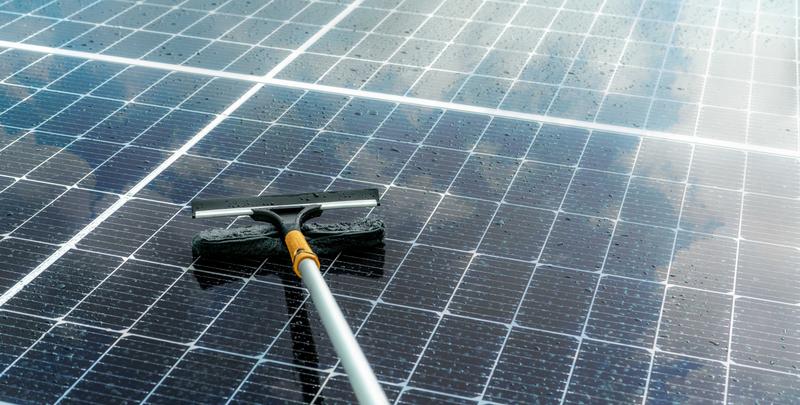
For those who’re hunting for a large-overall performance
Why Photo voltaic Panel Cleaning Matters
Photo voltaic panels capture Power at their very best when clean. Dust, pollen, chook droppings, and smog cut down effectiveness—sometimes by twenty% or even more. Typical cleaning can help keep ideal overall performance, increase panel lifetime, and safeguard your investment decision.
Primary Gains:
- Improved energy output
- Decreased electrical energy bills
- Extended panel lifespan
- Reduced possibility of micro‑cracks due to thermal hotspots
Forms of Photo voltaic Cleaning Instruments
Selecting the ideal Instrument relies on your setup, drinking water availability, and wished-for ease. Types consist of:
- Drinking water‑run solar brush systems
- Transportable solar panel cleansing package bundles
- Pure h2o cleaning methods
- Rotary solar brushes and extension poles
Drinking water Run Photo voltaic Brush Systems
These brushes connect to a drinking water supply and spin when dispensing h2o, combining cleansing and lubrication in a single step. The result: spotless panels with no scratching.
Crucial Capabilities:
- Built-in h2o feed in the brush head
- Soft bristles Harmless for glass surfaces
- Rotary motion decreases manual energy
- Mounts on extension poles for rooftop entry
Transportable Solar Panel Cleaning Kit
A complete photo voltaic panel cleansing package commonly features:
- Brush head (preset or rotating)
- Extension pole (adjustable lengths nearly six m)
- Hose adapters or brief‑join fittings
- Pure‑drinking water tank or filtration technique
- Comfortable microfiber towels or squeegees
- Non‑abrasive cleaning Remedy (if allowed)
Great things about All-in-A person Kits:
- Get started cleansing with nominal setup
- Compact for storage or travel
- Appropriate with household or industrial photo voltaic arrays
Pure Drinking water Solar Cleansing Devices
These techniques purify nearby h2o—taking away minerals and Grime—so it won’t depart scale or streaks. Pure water empowers professional-quality final results with out substances.
How It Works:
- Pretreatment filtration (sediment, carbon, ion Trade)
- Ultimate deionization or reverse‑osmosis phase
- Filtered drinking water circulated through brush for cleansing
- Residue‑totally free drying—no places or streaks left guiding
Rotary Solar Brush & Extension Poles
For giant solar arrays or business use, an influence-rotating head on the telescoping extension pole makes cleaning economical and Risk-free.
Benefits:
- Fewer Bodily hard work, quicker coverage
- Arrive at roofs and ground‑mounted panels simply
- Adjustable shaft lengths for different angles
- Universal swift‑join strategies for components
Focus on Security & Finest Practices
Cleaning solar panels consists of heights and slippery surfaces—protection initial:
- Use non‑conductive extension poles
- Keep away from pressure washers which will crack glass
- Function early or late to prevent glare and heat
- Dress in grips and slip-resistant footwear
- Observe regional drinking water‑use regulations or limits
Step‑by‑Step Cleaning Schedule
- Change off the solar inverter or make sure program is deactivated
- Rinse panels with lower‑force drinking water
- Make use of a brush (or solar brush package) with drinking water feed
- Scrub gently in overlapping, linear passes
- Rinse extensively with clear water
- Dry with microfiber squeegee or gentle towel—only if needed
Deciding on the Suitable Photo voltaic Panel Cleaning Tool
Think about your set up and also your drinking water accessibility:
Maintenance & Care Strategies
- Flush hose and brush soon after each use
- Keep dry, clean, and from UV publicity
- Replace worn brush heads—and Check out bristle softness
- Inspect seals and connectors for leaks
- Replace or clean up filters in pure‑water programs routinely
Eco-Helpful Cleansing Positive aspects
Correct cleaning prolongs solar panel effectiveness and lessens energy waste. Making use of drinking water by yourself—without the need of soaps or chemicals—aids protect regional ecology and avoids runoff air pollution.
How Photo voltaic Panel Cleansing Impacts ROI
Clever routine maintenance applying quality brushes and kits keeps method efficiency topped up, lowering the payback period and maximizing Power yield as time passes.
Expense Factors & Worth
- Water‑powered photo voltaic brushes are Price tag-successful and durable
- Pure water systems involve upfront investment but offer consistent, location‑absolutely free cleaning
- Rotary brush kits Increase efficiency—worthwhile for large installations
- DIY kits help you save labor charges; Skilled services Price tag a lot more but unlock your time and effort
Prevalent Utilizes of Solar Panel Brushes
- Household rooftops
- Professional solar farms
- RV or cellular installations
- Photo voltaic carports
- BIPV segments (developing‑integrated photovoltaics)
Buyer Testimonials & Use Conditions
“This solar panel cleansing brush produced a recognizable variation inside minutes—dust absent, no streaks, and our output improved!”
“Upgrading into a h2o‑driven photo voltaic brush saved several hours of scrubbing. Combined with a pure drinking water system, the panels seemed new.”
FAQs About Solar Panel Cleansing
How frequently ought to panels be cleaned?
Each individual 6 to 12 months, determined by your climate—far more often in dusty or pollen-large areas.
Can rain clean up solar panels?
Rain aids but doesn’t do away with Dust buildup or film layers—manual cleaning yields far better general performance.
Can I use tap h2o?
Tap drinking water may perhaps leave mineral residue. A
Can cleansing destruction panels?
Provided that abrasive applications or high-pressure washers are utilized. Often use comfortable bristles, lower-force, and observe maker pointers.
Professional Tricks for Photo voltaic Panel Homeowners
- Clear early morning or night in order to avoid thermal stress
- Monitor output details—if performance drops, clean up panels
- Retain panels angled—standing drinking water promotes algae advancement if still left also lengthy
- Rotate brush heads periodically to maintain even use
Conclusion: A Brush For each and every Need to have
Whether you’re on the lookout for a value-efficient
Investigate the total line of brushes and accessories designed especially for photo brush for cleaning solar panels voltaic cleansing at